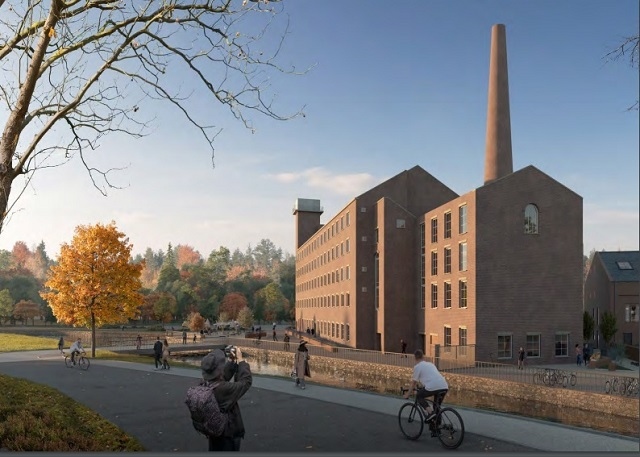Plans submitted for Crimble Mill and adjacent fields in Heywood
Date published: 20 July 2022

Photo: Urban Green
Artist's impression of plans to redevelop Crimble Mill, in Heywood
A developer has submitted plans to transform a crumbling historic mill into apartments and commercial space – paid for by building 150 homes on neighbouring fields.
The proposal would see the upper floors of Grade-II* listed Crimble Mill, in Heywood, converted into 33 flats, while the lower levels could be used for purposes ranging from shops, restaurants and museums to gyms, offices and exhibitions.
Dating back to 1825, the five-storey building is a rare example of a textile mill that illustrates the transition from water to steam power. It is likely to be the last large-scale water-powered rural mill to survive in Greater Manchester.
The ‘sensitive restoration’ of the mill complex would include the main range, as well as its two wings and Grade II-listed chimney.
The scheme also includes plans for 31 new homes in three ‘blocks’ on land around the mill on a ‘similar footprint’ to that of the existing buildings.

The prospect of restoring the mill – classed as ‘at risk’ by Historic England – is generally welcomed by the local community.
However, plans for an ‘enabling development’ of 150 homes on the opposite side of the River Roch has proven highly controversial since first appearing in the region’s joint development plan – now dubbed ‘Places for Everyone’.
Greenbelt campaigners previously demanded the whole 55-acre site be removed from the plan on the grounds it is too vulnerable to flooding, as well as objecting to the loss of the fields.
Read more: Call to remove Crimble Mill site from housing masterplan after floodsPublished: 19 March 2019
Read more: Campaigners braved awful weather to protest Crimble Mill greenbelt plans Published: 12 March 2019
But the applicant – Redwaters (Crimble) Ltd and Prescot Business Park – claims the flood risk would be addressed by replacing the Crimble Lane road bridge with a new single-span structure and removing the footbridge. There would also be a further ‘package’ of measures, including ‘structures to manage flood water flows around the mill’.
The developer also said that the harm caused by the development would be limited and is ‘demonstrably outweighed’ by its benefits.
“It is therefore considered that planning permission should be granted without delay, which is especially important bearing in mind the potential for further deterioration of the listed mill buildings,” planning papers add.

© Urban Green
Notable features included in the proposals include a new ‘public arrival space’ that could host an open archaeological exhibition and a new mill pond.
The applicant says further benefits of the proposal include extensive open space and recreation areas, job creation as well as land for the expansion of All Souls Primary School.

A total of 214 new homes would be provided across the three elements of the scheme.
The 33 flats within the mill building would be mainly two-bedroom, although there will be six one-beds and a trio of three-beds.
Properties adjacent to the mill and on land on the opposite side of the Roch would all be houses – 120 will have three bedrooms and 61 boast four bedrooms or more.
These are proposed to be market housing, with the developer arguing it is not financially viable to provide affordable homes without further development – which the site does not have space for.
Cars would enter the site from Heywood, south of the site via either Woodland Road or Crimble Lane. There would be 514 parking spaces, with nine disabled bays and room for 12 bikes.

© Urban Green
It is possible – if not likely – the site will be removed from the greenbelt should the Places for Everyone plan be signed off by the government. This means the developer would not have to prove that ‘very special circumstances’ in order to gain planning approval.
A planning statement on behalf of the applicant adds: “It is our view that residential redevelopment of the site in the way proposed (cross-subsidised with enabling development on adjoining land) is the best and most realistic option to secure the future of the mill.
“Indeed, it is considered that such a use is the only beneficial use that could safeguard the future of the listed mill buildings.”
A decision on whether to grant planning permission will be made by Rochdale Council.
Nick Statham, Local Democracy Reporter
Do you have a story for us?
Let us know by emailing news@rochdaleonline.co.uk
All contact will be treated in confidence.
Most Viewed News Stories
- 1Man killed in M62 crash after car hits bridge at junction 19
- 2GMP detain carjacker minutes after committing burglary in Rochdale
- 3Abandoned shopping centre to be brought back to life as a banqueting hall
- 4The land has laid dormant for years, now £15m could help see it transformed
- 5How much council tax will go up in the Rochdale borough for each household
To contact the Rochdale Online news desk, email news@rochdaleonline.co.uk or visit our news submission page.
To get the latest news on your desktop or mobile, follow Rochdale Online on Twitter and Facebook.

